Ingersley Hall, later Savio House, stands to the east of the town of Bollington, Cheshire, England. The house was built in about 1775 for John Gaskell. Extensions were added to it in 1833 for John Upton Gaskell. [1] The house was sold by the Gaskell family in 1933. In the 1950s it was taken over by a religious order, the Salesians of Don Bosco, and renamed Savio House. [2] As of 2011 the house is used as a retreat and activities centre for young people. [3] The front of the house is constructed in ashlar, with the remainder in coursed sandstone rubble. The house is roofed in Welsh slate and has stone chimneys. It has a rectangular plan and is in two storeys. The architectural style is Greek Revival. The north front is symmetrical with five bays divided by pilasters. The porch is in Doric style. The west front has eight bays, the central three of which were in the original house. All the windows in the north and west fronts are sashes with 12 panes. The south door is in Tuscan style, and was probably moved from the west front. The house is recorded in the National Heritage List for England as a designated Grade II listed building. [4] Also listed at Grade II is a former coach house to the south of the hall, built in about 1850, and converted into a conference hall in about 1950. [5]

Lyme Park is a large estate located south of Disley, Cheshire. The estate is managed by the National Trust and consists of a mansion house surrounded by formal gardens, in a deer park in the Peak District National Park. The house is the largest in Cheshire, and is recorded in the National Heritage List for England as a designated Grade I listed building.

Eaton Hall is the country house of the Duke of Westminster. It is set within a large estate 1 mile (2 km) south of the village of Eccleston, in Cheshire, England. The house is surrounded by formal gardens, parkland, farmland and woodland. The estate covers an area of about 10,872 acres (4,400 ha).

Tabley House is a former stately home in Tabley Inferior, some 3 kilometres (1.9 mi) to the west of the town of Knutsford, Cheshire, England. The house is recorded in the National Heritage List for England as a designated Grade I listed building. It was built between 1761 and 1769 for Sir Peter Byrne Leicester, to replace an older hall nearby, and was designed by John Carr.
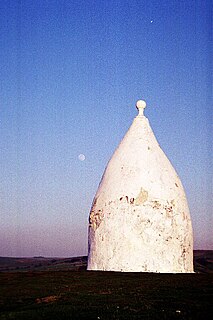
White Nancy is a structure at the top of the northern extremity of Kerridge Hill, predominantly in the Parish of Rainow, overlooking the village of Kerridge and the town of Bollington, Cheshire, England. Since 1966 it has been recorded in the National Heritage List for England as a designated Grade II listed building. Its profile forms the logo for the town of Bollington. As to the origin of the name White Nancy, there are several theories: it may have been named after one of the Gaskell daughters, Nancy, or maybe after the horse that is said to have hauled the table top up the hill. However, much the most likely origin is that the hill once had upon it an Ordnance marker, as installed by mapping surveyors. Early maps noted the location as Northern Nancy.
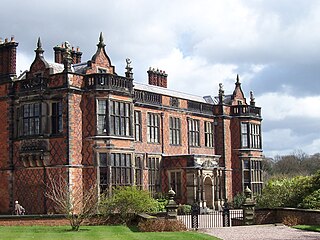
Arley Hall is a country house in the village of Arley, Cheshire, England, about 4 miles (6 km) south of Lymm and 5 miles (8 km) north of Northwich. It is home to the owner, Viscount Ashbrook and his family. The house is a Grade II* listed building, as is its adjacent chapel. Formal gardens to the southwest of the hall are also listed at Grade II* on the National Register of Historic Parks and Gardens. In the grounds are more listed buildings, a cruck barn being listed as Grade I, and the other buildings as Grade II.
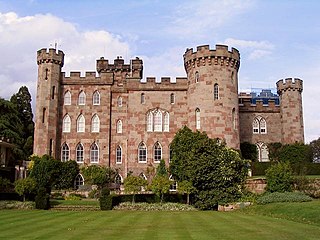
Cholmondeley Castle is a country house in the civil parish of Cholmondeley, Cheshire, England. Together with its adjacent formal gardens, it is surrounded by parkland. The site of the house has been a seat of the Cholmondeley family since the 12th century. The present house replaced a timber-framed hall nearby. It was built at the start of the 19th century for George Cholmondeley, 1st Marquess of Cholmondeley, who designed most of it himself in the form of a crenellated castle. After the death of the Marquess, the house was extended to designs by Robert Smirke to produce the building in its present form. The house is designated by English Heritage as a Grade II* listed building.

Birtles Hall is a country house in the parish of Over Alderley, Cheshire, England. It was built in about 1819 for the West Indies merchant Robert Hibbert.

Cogshall Hall is a country house near the village of Comberbach, Cheshire, England. It was built in about 1830 for Peter Jackson. A kitchen wing was added to the rear during the early 20th century. It is constructed in red-brown brick, and has a slate hipped roof. It is rectangular in plan, and has two storeys. Its architectural style is Georgian. The entrance front has five bays and an Ionic portico. There is a similar, smaller portico on the right side. The house is recorded in the National Heritage List for England as a designated Grade II* listed building. The lodge to the hall was built at about the same time. It has a Tuscan porch with a pediment, and is listed at Grade II. The architectural historian Nikolaus Pevsner refers to the lodge as being "ambitious".

Cranage Hall is a former country house in the village of Cranage, Cheshire, England. It was built in 1828–29 for Lawrence Armitstead, and designed by Lewis Wyatt. In 1932 a parallel wing was added. Since the hospital closed, it has been used as a hotel and conference centre owned and run by the Principal Hayley hotel group. The building is constructed in red brick with blue brick diapering, and in yellow sandstone. It is roofed in slate. The architectural style is Elizabethan. The building is in two storeys plus a basement, and it has eight bays. The first and fourth bays are in stone; the others are in brick. In front of the sixth and seven bays is a two-storey stone porch with four fluted Doric columns, an entablature with a frieze, and a balcony with an openwork balustrade. Between the third and fourth bays is a slim octagonal tower with an ogee cap and a weathervane. The house is recorded in the National Heritage List for England as a designated Grade II listed building.
Endon Hall is a country house to the south of Bollington and to the west of Kerridge Hill in Cheshire, England. It was built for William Clayton who developed a quarry nearby. Building of the house started in the 1830s, and it was enlarged in the 1850s. Associated with the house are two structures recorded in the National Heritage List for England as designated Grade X listed buildings. In the farm to the east of the house are stables, built at the same time as the house. They are constructed in coursed buff sandstone rubble with ashlar dressings, and have Kerridge stone-slate roofs. The stables are in two storeys, with a courtyard plan. They have a symmetrical front of five bays, with the central and end bays stepped slightly forward. In the centre bay is a coach entrance. The parapet is castellated. On the roof is a two-tier dovecote with a clock in the upper tier. Also on the roof is a hexagonal wooden open bellcote with a copper-domed roof and a weathervane. In the garden to the south of the house is a sandstone icehouse, built in about 1840.

Hankelow Hall is a former country house to the north of the village of Hankelow, Cheshire, England.
Haughton Hall is a country house to the east of the village of Haughton, Cheshire, England. It was rebuilt between 1891 and 1894 for the shipowner and art collector Ralph Brocklebank. The architect was J. F. Doyle, the design being influenced by the Old English picturesque style of Norman Shaw. The house was altered in about 1950, reducing it from three storeys to two, and replacing tile-hanging with roughcast. It is constructed in red brick, some of which has been roughcast, and has red tiled roofs. The house has an L-shaped plan. The garden front is in two storeys and has five bays; there is a single-storey five-bay wing to the east, and a three-storey three-bay service wing to the north. In the garden front are three bay windows, a Venetian window and a door. Above the door is a sundial. The house is recorded in the National Heritage List for England as a designated Grade II listed building.
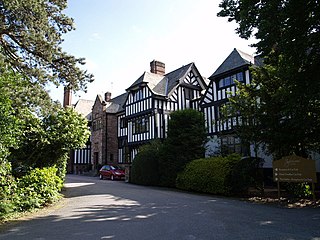
Inglewood is a house to the north-west of the village of Ledsham, Cheshire, England. It was built in 1909, but is dated 1915. The house was built for Frederick H. Fox, a Liverpool millionaire who made his fortune in marine insurance. As of 2011 it is a hotel called Inglewood Manor Hotel. The house is mainly half-timbered, with stone dressings, and brick chimneys decorated with diapering. It is roofed with Lakeland slate. Its architectural style is late Arts and Crafts. The house has a rectangular plan, with three fronts in two and three storeys. The entrance is on the east front, which has eight bays; the south and west fronts each have five bays. On the south side is a balcony overlooking the gardens. The house is recorded in the National Heritage List for England as a designated Grade II listed building. Also listed Grade II are the south and west terrace walls of the garden, and the east terrace walls and a pergola.
Lymm Hall is a moated country house in the village suburb of Lymm in Warrington, Cheshire, England. It is recorded in the National Heritage List for England as a designated Grade II* listed building.

Mobberley Old Hall is a country house in the village of Mobberley, Cheshire, England. It was built in 1612 and extended later in the 17th century. The house stands in gardens which retain part of the moat and ancient yew trees. The house is recorded in the National Heritage List for England as a designated Grade II* listed building, and the grounds contain two Grade II listed buildings.
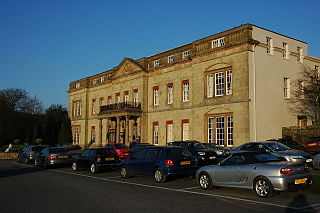
Shrigley Hall is a former country house standing to the northwest of the village of Pott Shrigley, Cheshire, England. It has since been used as a school, when a chapel was added, and later as a hotel and country club operated by The Hotel Collection.

Willaston Old Hall is a former manor house in the village of Willaston, in the unitary authority of Cheshire West and Chester, England. The building carries the date 1558, but both the authors of the Buildings of England series, and Figueirdo and Treuherz, argue that this date is too early for the architectural style of the house. Figueirdo and Treuherz are of the opinion that it was built in the early 17th century for Hugh Bennet. The house is constructed in red brick and stands on a red sandstone plinth. It has sandstone dressings and quoins, and a slate roof with stone ball finials. The entrance front is symmetrical, and consists of five bays, with three storeys. The central and the outer bays project forward and are gabled. The windows are mullioned and transomed. The house is recorded in the National Heritage List for England as a designated Grade II* listed building.

Willington Hall is a former country house in the parish of Willington, Cheshire, England. It was extended in 1878, but reduced in size in the 1950s, and has since been in use as a hotel.

The Gaskell Memorial Tower and King's Coffee House are in King Street, Knutsford, Cheshire, England. As originally built, it had the triple function of being council offices, a coffee house, and a memorial to the novelist Elizabeth Gaskell, a former resident of the town who is often known as Mrs Gaskell. The building was designed by Richard Harding Watt with assistance from W. Longworth, and was opened in 1907. Its design incorporates features of many styles of architecture, and has not been praised by all critics. Incorporated on the tower are two depictions of Mrs Gaskell, a stone bust and a bronze relief. The building is recorded in the National Heritage List for England as a designated Grade II* listed building. The building is owned by Knutsford Town Council but since the early 1970s it has been used as a restaurant.
Rainow is a civil parish in Cheshire East, England. It contains 69 buildings that are recorded in the National Heritage List for England as designated listed buildings. Of these, three are listed at Grade II*, the middle grade, and the others are at Grade II. Apart from the village of Rainow, the parish is now rural, although in the past there has been industry in the form of small mills. One of the listed buildings is a former water mill, but most are country houses and associated structures, smaller houses and cottages, and farmhouses with farm buildings. Otherwise the listed buildings are milestones, mile posts, boundary stones, weirs, a bridge, a folly, stocks, and two churches.
Coordinates: 53°17′36″N2°05′00″W / 53.29324°N 2.08322°W
| This article about a Cheshire building or structure is a stub. You can help Wikipedia by expanding it. |
| This article about a listed building in the United Kingdom is a stub. You can help Wikipedia by expanding it. |